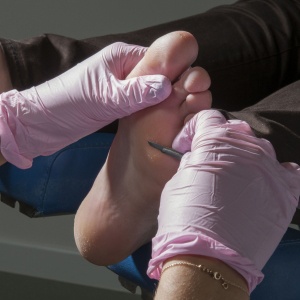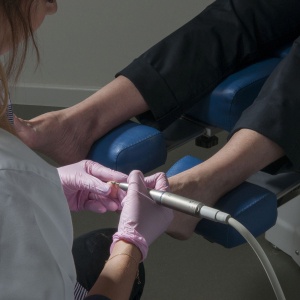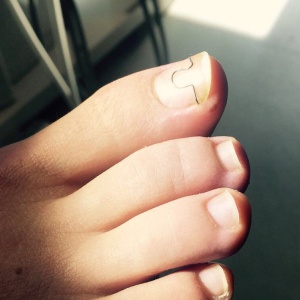PODOLOGY
WHAT DOES A PODOLOGIST DO?
Our podologists will help you with various complaints related to your foot. There may be problems with the shape or mobility of the foot; overloading is often a source of pain and problems. Our podologists are involved in both research and nursing work. They also offer well-founded advice, both on possible follow-up treatments and on the choice of shoes. The main treatments offered by our podologists are briefly explained below.

PODOLOGICAL EXAMINATION
This includes a biomechanical study and a gait analysis. It examines in detail how the patient walks, how mobile the foot and ankle are, and whether the patient is restricted in any kind of movement. On the basis of this analysis, it is decided what the following steps are: insoles, silicone orthotic inlays, felt therapy, a referral to a specialist, GP or physio, etc..

PODOLOGICAL FOOT CARE
The podologist listens to the patient’s complaint and studies the foot. All nails are cut straight to avoid ingrown toenails. The nail is nicely smoothed with a pear cutter. Now the nail grooves are cleaned and all calluses removed with a callus knife. Any corns are also removed. With the sander, everything is made extra soft afterwards. A good foot cream closes the treatment.

DIABETIC FOOT CARE
In diabetic foot care, the podologist takes extra care. After all, every minor wound can have major consequences. So it’s precision work. The nails are therefore kept a little longer on the side than in the middle, so that it is absolutely impossible for them to grow in. Or a U-shape with slightly longer nail angles.

NAIL BRACES
Some nails are slightly convex, which causes them to press and sometimes even grow in. That’s why a nail brace is fitted. A thin brace is placed on the nail that pulls the nail up. The brace grows along with the nail and is replaced after a few weeks until the nail finally stands up again and the danger of ingrowth is gone.

FELT THERAPY
An open wound on the base of the foot, a pressure point on or under the toe, calluses…. It can cause a lot of pain. In felt therapy, felt is therefore placed around these sores. In this way, the pressure on that spot or wound disappears and walking becomes a lot more bearable.

SILICONE ORTHOTIC INLAYS
If you suffer from a hammer toe, claw toe or toes that grow on top of each other, a silicone orthotic inlay may help. This device is made directly on your foot and will protect your toes or steer them into a more correct position. For example, an inflammation can be temporarily relieved thanks to such a silicone inlay, the inlay can ensure that your toes remain neatly in line or prevent your toe tips from being overloaded. Sometimes protective, sometimes corrective. From protecting to restoring, in other words.
WHAT CAN A VISIT TO THE PODOLOGIST DO FOR ME?
FOR WHOM?
Patients are often referred to our podologists. However, you can also make an appointment on your own initiative.
Our feet have to put up with a lot; they carry us all day long, and certainly those whose job involves a lot of standing or walking should take good care of them.
Foot problems often occur slowly and creepingly. Tackling the problem is therefore often delayed, with the result that pain and discomfort systematically increase. Which is a shame if you know that very often, small interventions can make a big contribution to your daily walking and living comfort. Very often we hear: I’m alive again! I should have stopped by much earlier.
BENEFITS
Your walking comfort improves significantly
You have less or no more pain
You regain your mobility
You prevent problems from becoming worse
HOUSE OF FEET
Monnikenwerve 171
8000 Brugge
T 050 31 68 00
